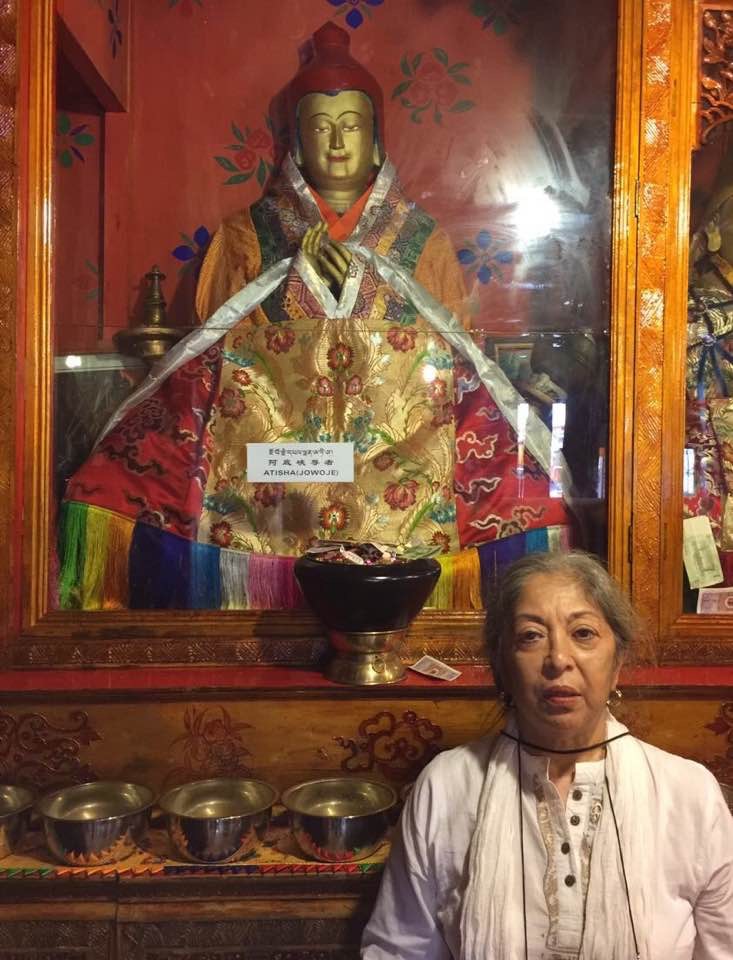Lest we forget: Atiśa
Written by: Lubna Marium
Posted on: Tuesday 16th of August 2016 09:06:06 PM

Arts Gaze by Lubna Marium
Lest we forget: Atiśa
'Dharma is the lamp (which guides us through)
The darkness of ignorance,
And it is the ship in which one
Crosses the ocean of existence.'
(Dipankara Srijnana, Charya-giti, verse 24)
The above lyrics, from medieval Bengal, is an example of the earliest ‘kirtan’, or musical accolade, which began the practice of presenting philosophical notions through music, and is continued till date by our Bauls. Written by 'Atiśa', meaning 'preeminent', which is the honorific title of the great Buddhist saint, Dipankara Srijnana, of 10th century Bengal, this song is part of a bulk of Buddhist literature, known as 'charya-giti'. Atiśa himself states in 'Carya-giti-vritti', 'Pure philosophy (samyak siddhanta) is explained here in a two-fold way. It is a 'vajra-giti' in form and in it is primarily shown 'nirodha-satya' (the cessation of suffering)'.
Preserving history, specially the history of thought and philosophy, is a vital task, as it is through this account of the past that a nation understands it's present identity and is able to preserve it responsibly. Today, it has become imperative for Bangladesh to look back and comprehend the many facets of history that has made us who we are. I would like to begin this sojourn, into history, with an account of, probably one of the most influential sons of this soil, Buddhist Mahasiddha Atiśa Dipankara Srijnana, from 10th century Bengal, whose indelible message of compassion still resounds all over the world.
From the abounding hagiographies of Atiśa we learn that he was born into an affluent Hindu household in Vikrampura (present Bangladesh) and named Chandragarbha. However, following the footsteps of his spiritual mentor, the 'Enlightened' Gautama Buddha, he abandoned hearth and home to become an ascetic and begin a quest for knowledge that led him to far away shores. Having reached the pinnacle of scholarship and enlightenment, Atiśa's fame spread so far and wide, that a learned Tibetan king invited him to spread the word of Sakyamuni in the 'Land of Snow'.
On his way to Tibet, Atiśa, spent a year in the Kathmandu Valley. Much of this detailed information is based on the 'Itinerary of Atisha's Travels', authored by Dromton, the chief disciple of the Buddhist master Atiśa and the initiator of the Kadampa school of Tibetan Buddhism. From this we learn about Atiśa's role in the foundation of the Bikramshila Vihar of Tam Bahil in what is now the quarter of Kathmandu town known as Thamel. It is at this time that Atiśa composed the 'Charyasamgrahapradipa' that contains some kirtan verses.
Although Buddhism had been introduced into Tibet some two hundred years earlier by Padmasambhava and Shantarakshita, Buddhist practice in the country had largely been destroyed during the anti-Buddhist purges of the Tibetan king, Lang Darma (circa 836 AD), a follower of Bön, the pre-Buddhist religion of Tibet.
Invited in 1042 by Jangchub Ö, a ruler of Ngari in western Tibet, Atiśa was asked to present a Dharma that everybody could follow and that would show how all the paths of Sutra and Tantra could be practiced together. At Ngari, he was very impressed with the king's request for "a teaching of the people. Had he been asked for advanced empowerments into tantric deity systems, Atiśa would have been far less pleased". In response, Atiśa wrote 'Bodhi-patha-pradipa' or 'Lamp for the Path', the original Lamrin text that served as the basis for the revival of pure Buddhist practice in Tibet.
Lamrim is a special set of instructions that includes all the essential teachings of Buddha arranged in such a way that all his Hinayana and Mahayana teachings can be put into practice in a single meditation session. The stages of the path to enlightenment, or Lamrim in Tibetan, is the backbone of Kadampa Buddhism, which inspires all to be compassionate towards fellow humans.
'I shall take no delight in attaining enlightenment
By a speedy means for my own self,
But shall remain until the end of the future,
If it be a cause for (helping) one limited being.'
(Dipankara Srijnana, Bodhi-patha-pradipa, verse 29)
Atiśa chose to live the last nine years of his life at the Buddhist Monastery of Nyethang, near Lhasa, nested between ethereal and verdant hills besides the Lhasa River, under an azure sky - almost a bit of heaven on earth. In Tibet it is, endearingly, said that the Master chose this place because of its proximity to River Lhasa, which reminded him of the land of his birth.
Leave a Comment:
Read what others says about us
- documenting for posterity
- performing transformation
- cherishing tradition
- the body speaks anew
- in conversation with two shadhona dancers
- gidree bawlee: empowerment through art
- in conversation with shadhona dancer sinthia yasmin nupur
- don’t hold your breath!
- #freetagore
- history of rhythm, in pixels
- of monsoons, myths and manasa
- culture: the present site for struggle
- the art & politics of documentation
- and, theatre strikes back!
- lest we forget: atiśa
- dancing away boundaries
- dance-why?
- haha
- hhh
- heked
Advertisement #1

Advertisement #2

Advertisement #3
